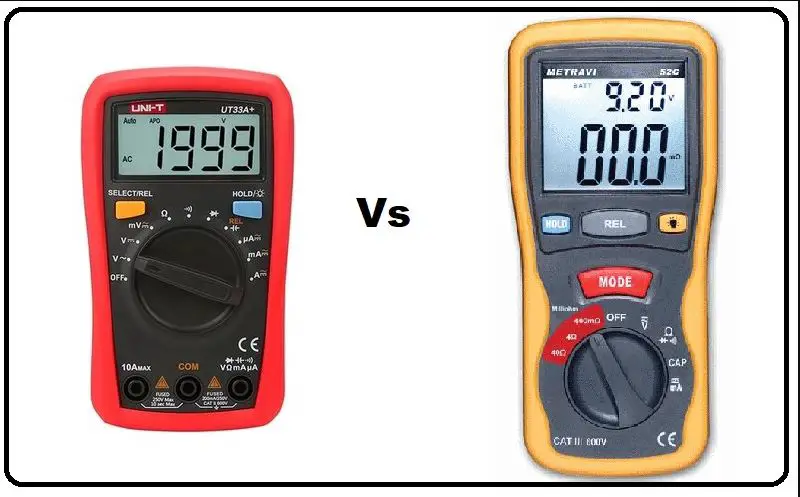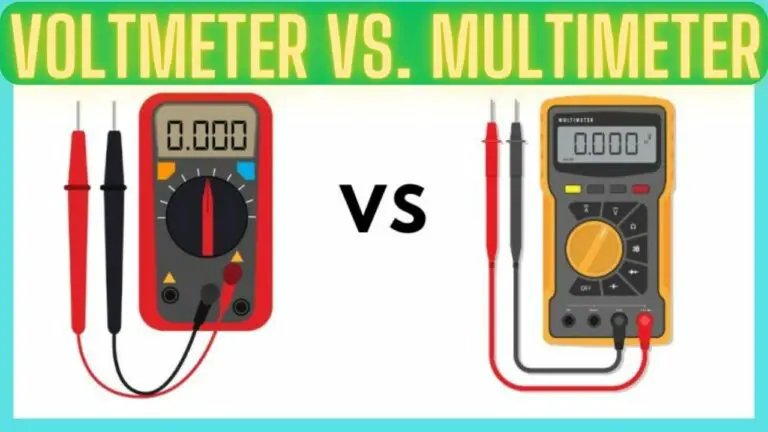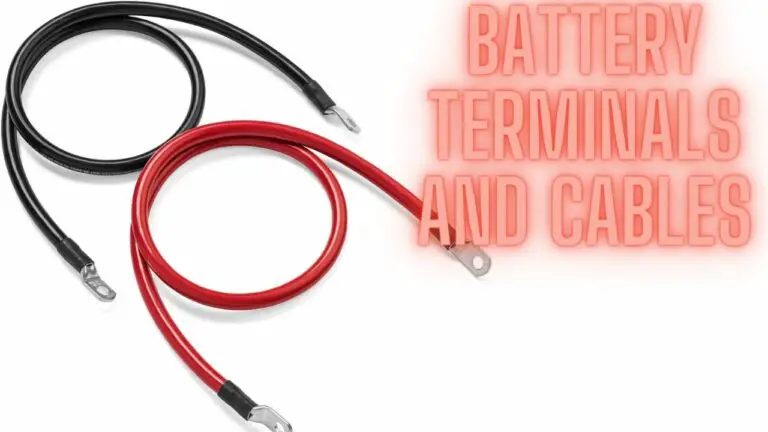Ohmmeter vs Multimeter | Complete Difference
Introduction:
Resistance to electricity is a force that opposes the flow of current. We use some instruments to measure this resistance in electricity Ohmmeter and multimeter are some of those instruments that measure electrical resistance in the circuit. Therefore, if you want to know the difference between an ohmmeter and a multimeter then you have come to the right place we will discuss in this article, how they both work and how they differ and what are their functions.
Introduction to Electrical Measurements
In the realm of electrical engineering and maintenance, accurate measurements are essential for diagnosing faults, testing circuits, and ensuring safety. Instruments such as ohmmeters and multimeters play a vital role in measuring electrical parameters such as resistance, voltage, current, and continuity.
What is ohmmeter?
An ohmmeter is a simple instrument used to measure electrical resistance. An electronic device measures small values of resistance in a circuit. Three types of ohmmeters calculate the values of resistance that are micro-ohmmeter, milli-ohmmeter, and mega-ohmmeter. An ohmmeter has mainly been used for electrical resistance because the ohm is the measuring unit of resistance. Moreover, it also tells us about the situation of the capacitors in the circuit.
Ohmmeter forms its circuit, so when you want to take the reading of resistance value you have to disconnect the power supply first. According to the types of ohmmeter, all resistance values from high to low have been measured in micro, milli, and mega ohmmeters. An ohmmeter consists of a current meter, battery source, and resistors.
Working of ohmmeter:
Ohmmeter apparatus consists of two test leads and one needle that is controlled by the battery of the circuit. The two test leads have shorted together in the initial, and then the needle from going from zero to the highest point, and resistance can be measured when these two test leads are detached. These two leads are connected to a battery then the battery has discharged and the needle moves to its lowest point of zero so, the resistance would be zero at that time.
Advantages of Ohmmeters
Ohmmeters offer several advantages that make them valuable tools in electrical testing and troubleshooting. Here are some of the key advantages of ohmmeters:
- High Precision: Ohmmeters are specifically designed for measuring resistance with high accuracy and precision. They provide reliable readings of resistance values, allowing for precise analysis of electrical circuits and components.
- Simplicity: Ohmmeters are relatively simple to use, typically featuring a straightforward interface with a dial or switch for selecting resistance ranges. This simplicity makes them accessible to users with varying levels of technical expertise, from beginners to experienced professionals.
- Dedicated Functionality: Ohmmeters are dedicated instruments designed solely for measuring resistance. Unlike multimeters, which offer a range of measurement functions, ohmmeters focus exclusively on resistance measurements, allowing for specialized testing of resistors and other components.
- Cost-Effective: Ohmmeters are often more affordable than multimeters, especially for basic models with limited features. This makes them a cost-effective option for individuals and organizations seeking a dedicated resistance measurement tool without the additional expense of multimeter functionality.
- Quick and Easy Testing: With their dedicated functionality and simple operation, ohmmeters enable quick and easy testing of resistance in electrical circuits and components. Users can obtain resistance readings rapidly, allowing for efficient troubleshooting and analysis.
- Compact and Portable: Ohmmeters are typically compact and lightweight, making them easy to transport and use in various settings. Their portability allows users to perform resistance measurements conveniently, whether in a laboratory, workshop, or field environment.
- Battery-Powered Operation: Many ohmmeters are battery-powered, offering the flexibility to use them in locations where access to a power outlet may be limited or unavailable. Battery-powered operation ensures that users can perform resistance measurements without relying on external power sources.
- Durability and Reliability: Ohmmeters are built to withstand the rigors of regular use, with sturdy construction and durable components. This durability ensures reliable performance over time, even in challenging operating conditions.
- Specific Resistance Ranges: Ohmmeters often feature specific resistance ranges tailored to the needs of different applications. Users can select the appropriate range for the resistance being measured, allowing for accurate and efficient testing of a wide range of components.
- Educational Tool: Ohmmeters serve as valuable educational tools for teaching fundamental concepts of electrical resistance and circuit analysis. They allow students to gain hands-on experience with resistance measurement techniques, enhancing their understanding of electrical theory and practice.
Overall, ohmmeters offer a range of advantages, including high precision, simplicity, dedicated functionality, cost-effectiveness, portability, durability, and educational value. These advantages make them essential instruments for measuring resistance in electrical circuits and components, whether in educational, industrial, or research settings.
Limitations of Ohmmeters
Despite their usefulness in measuring resistance, ohmmeters have certain limitations that users should be aware of. Here are some of the key limitations of ohmmeters:
- Limited Functionality: Ohmmeters are designed specifically for measuring resistance and cannot perform other types of electrical measurements such as voltage, current, capacitance, or frequency. As such, they are not suitable for comprehensive electrical testing and diagnostics.
- Lack of Versatility: Unlike multimeters, which offer a wide range of measurement functions, ohmmeters are limited in their versatility. They cannot measure parameters other than resistance, making them less useful for tasks that require multiple measurements.
- Inability to Detect Open Circuits: Ohmmeters may not always be able to detect open circuits in a circuit or component. If a circuit is open (i.e., broken or disconnected), the ohmmeter may indicate infinite resistance, leading to difficulty in diagnosing the problem.
- Dependence on Battery Power: Many ohmmeters rely on battery power for operation. If the battery is weak or depleted, the accuracy and reliability of resistance measurements may be compromised. Users must ensure that the ohmmeter is equipped with a sufficiently charged battery for accurate measurements.
- Limited Measurement Range: Ohmmeters typically have a limited measurement range for resistance values. If the resistance being measured exceeds the ohmmeter’s range, the instrument may not provide accurate readings or may indicate an overload condition.
- Susceptibility to External Factors: Ohmmeter readings may be affected by external factors such as temperature, humidity, and electromagnetic interference. These factors can introduce errors or inaccuracies in resistance measurements, particularly in uncontrolled environments.
- Sensitivity to Contact Resistance: Ohmmeters are sensitive to contact resistance between the test probes and the circuit or component being measured. Poor or unstable connections can lead to inaccurate readings or fluctuations in resistance values.
- Inability to Measure Resistance in Powered Circuits: Ohmmeters cannot accurately measure resistance in circuits that are powered or energized. Attempting to measure resistance in a live circuit can damage the ohmmeter or pose a safety risk to the user.
- Limited Diagnostic Capability: While ohmmeters can indicate whether a component has continuity or is open-circuited, they may not provide detailed diagnostic information about the underlying cause of the resistance value. Additional testing and analysis may be required to identify and resolve the problem.
- Not Suitable for High-Frequency Signals: Ohmmeters are not designed to measure resistance in circuits carrying high-frequency signals, such as radiofrequency or microwave circuits. Specialized instruments, such as vector network analyzers, are required for accurate impedance measurements in high-frequency applications.
Overall, while ohmmeters are valuable tools for measuring resistance in electrical circuits and components, they have limitations that users should consider. These limitations underscore the importance of selecting the right tool for the task at hand and using ohmmeters in conjunction with other instruments for comprehensive electrical testing and diagnostics.
Types of ohmmeter:
According to the applications of an ohmmeter, three types have given below:
1- Series type ohmmeter:
In series type, ohmmeter the component that we want to measure has connected in series, and resistor 2 has connected parallel. Therefore, when the value of resistance is zero then the current flow is high there is no barrier to current flow, when the resistance increases the flow of current slowdown. When the measuring component is detached then there is high resistance and the meter shows infinity resistance which means no flow of current. When the measuring component has connected in series then the needle of the meter moves towards the left and shows high resistance and vice versa.
2- Shunt type ohmmeter
In this type of ohmmeter, the measuring component has connected parallel with the battery in the circuit to measure the low-value resistance. Measuring component connected across the terminal A&B with battery and meter in the circuit. When the resistance of the component is high then the needle of the meter shows full-scale deflection towards the left. Therefore, there is no current in the left direction and a smooth flow of current in the right direction.
3- Multi-range ohmmeter
This multi-range ohmmeter has an adjuster to adjust the range of the resistance that we want to measure. If you want to measure the resistance below 10 then you have to adjust the resistance value to 10ohms so, that the measuring component has connected in parallel. The resistance value can be measured according to the deflection of the needle.
Applications of Ohmmeters
Ohmmeters find applications in various industries and settings where measuring resistance is essential for testing, troubleshooting, and maintenance of electrical circuits and components. Here are some common applications of ohmmeters:
- Testing Resistors: One of the primary applications of ohmmeters is to test resistors for their nominal resistance values and tolerance. By connecting the leads of the ohmmeter to the terminals of a resistor, users can verify whether the resistance matches the specified value indicated by the resistor’s color code or markings.
- Verifying Continuity: Ohmmeters are often used to check for continuity in electrical circuits, wires, and connections. Continuity testing involves verifying whether there is a complete path for electrical current flow between two points in a circuit. An ohmmeter can detect continuity by measuring very low resistance values (close to zero ohms) between the test points.
- Diagnosing Open Circuits: Ohmmeters are useful for diagnosing open circuits, where there is a break or discontinuity in the electrical path. By measuring the resistance between different points in a circuit, users can identify areas where the resistance is infinite (indicating an open circuit) and troubleshoot the underlying cause, such as a broken wire or disconnected component.
- Checking Ground Connections: Ohmmeters can be used to verify the integrity of ground connections in electrical systems and equipment. By measuring the resistance between the ground terminal and a known reference point (e.g., earth ground), users can ensure that ground connections are properly established and conductive.
- Testing Electrical Cables and Wires: Ohmmeters are employed to test the integrity of electrical cables, wires, and harnesses for continuity and resistance. By measuring the resistance between the conductors in a cable, users can identify shorts, breaks, or damaged insulation that may affect electrical performance.
- Detecting Faulty Components: Ohmmeters are instrumental in identifying faulty components in electronic circuits and devices. By measuring the resistance of individual components (e.g., capacitors, inductors, diodes) in isolation from the circuit, users can assess their functional status and determine whether they are within acceptable tolerance limits.
- Calibrating Sensors and Transducers: Ohmmeters are used in calibration procedures for sensors, transducers, and other measurement devices that rely on resistance-based sensing elements. By applying known resistance values and comparing the measured readings, users can calibrate the sensitivity and accuracy of these devices.
- Quality Control in Manufacturing: Ohmmeters play a vital role in quality control processes during the manufacturing of electronic products and components. They are used to verify the consistency and conformity of resistance values in resistive elements, ensuring that products meet performance specifications and standards.
- Field Service and Maintenance: Ohmmeters are indispensable tools for field service technicians and maintenance personnel tasked with diagnosing and repairing electrical systems and equipment. They are portable, easy to use, and capable of quickly assessing the condition of circuits and components in various environments.
- Educational and Training Purposes: Ohmmeters serve as valuable educational tools for teaching fundamental concepts of electrical resistance, continuity, and circuit analysis in academic and training settings. They provide hands-on experience for students learning about electrical circuits and electronics.
What is a multimeter?
An electronic multifunctional instrument multimeter uses to measure the current (AC or DC), resistance, and voltage (AC or DC). It can also act like an ohmmeter, ammeter, and voltmeter because it can measure all these three parameters. It consists of a display, power source, probes, and power supplies. This advanced electronic instrument can also measure some other parameters like temperature, capacitance, frequency, transistor gain, and voltage drop of diodes.
Working:
Multimeter instruments have two leads, probes, and three ports according to the requirement for proper measurements. The two leads are black and red, the black lead has connected to the common ports, and the red has connected to the other ports of the instrument. When you want to measure the voltage, you have to set the range of your knob; if the voltage is high, you have to set your knob up to 20V DC. For low voltages, you have to set the range up to 2V in the multimeter.
For obtaining the measurements of the required components, you have to touch the end of the probe with the end terminal of the component but be aware not to touch the end of the metal bar in the tester because it gives you an electric shock that is dangerous for you.
Advantages of Multimeters
Multimeters are versatile tools used for measuring various electrical parameters such as voltage, current, resistance, capacitance, continuity, and sometimes temperature. They offer several advantages that make them indispensable instruments for electrical testing and troubleshooting. Here are some of the key advantages of multimeters:
- Versatility: One of the primary advantages of multimeters is their versatility. They combine the functionality of multiple measuring instruments into a single device, eliminating the need to carry and switch between different tools. With a multimeter, users can measure voltage, current, resistance, and other parameters, making it suitable for a wide range of electrical tasks.
- Multiple Measurement Functions: Multimeters offer a comprehensive range of measurement functions beyond just resistance. Depending on the model, they can measure AC and DC voltage, AC and DC current, resistance, capacitance, frequency, continuity, diode testing, and sometimes temperature. This versatility allows users to perform various electrical tests and diagnostics using a single instrument.
- All-in-One Solution: Instead of purchasing separate instruments for voltage, current, and resistance measurements, users can invest in a multimeter to fulfill all their testing needs. This not only saves money but also reduces clutter and simplifies the tool kit, making it more convenient to carry and use in different settings.
- Digital Display: Many modern multimeters feature a digital display, which provides clear and accurate readings of measured parameters. Digital displays are easy to read, even in low-light conditions, and often offer additional features such as backlighting, auto-ranging, and data hold functions.
- Accuracy and Precision: Multimeters are designed to provide precise and accurate measurements across a wide range of electrical parameters. With proper calibration and care, multimeters can deliver reliable results, making them suitable for professional and scientific applications where accuracy is critical.
- Ease of Use: Despite their advanced capabilities, multimeters are designed to be user-friendly, with intuitive controls and interfaces. Most multimeters feature a rotary dial or selector switch for selecting measurement functions and ranges, making them easy to operate even for beginners.
- Real-Time Monitoring: Some multimeters offer real-time monitoring capabilities, allowing users to observe changes in electrical parameters over time. This can be useful for troubleshooting intermittent faults, monitoring circuit performance during testing, or conducting experiments in a laboratory setting.
- Portable and Lightweight: Multimeters are typically compact and lightweight, making them easy to carry and use in various environments. Whether in the field, laboratory, or workshop, users can conveniently take their multimeter wherever it’s needed to perform electrical measurements.
- Battery-Powered Operation: Many multimeters are powered by batteries, providing the flexibility to use them in locations where access to a power outlet may be limited or unavailable. Battery-powered operation ensures that users can perform measurements quickly and efficiently without relying on external power sources.
- Data Logging and Connectivity: Some advanced multimeters offer additional features such as data logging and connectivity options. These features allow users to record and analyze measurement data over time, store measurements for future reference, and interface with external devices or software for further analysis.
Overall, multimeters offer a wide range of advantages, including versatility, multiple measurement functions, all-in-one functionality, digital displays, accuracy, ease of use, real-time monitoring, portability, battery-powered operation, and additional features such as data logging and connectivity. These advantages make multimeters essential tools for electrical testing and troubleshooting in various industries, including electronics, telecommunications, automotive, aerospace, and more.
Limitations of Multimeters
Despite their usefulness in measuring resistance, ohmmeters have certain limitations that users should be aware of. Here are some of the key limitations of ohmmeters:
- Limited Functionality: Ohmmeters are designed specifically for measuring resistance and cannot perform other types of electrical measurements such as voltage, current, capacitance, or frequency. As such, they are not suitable for comprehensive electrical testing and diagnostics.
- Lack of Versatility: Unlike multimeters, which offer a wide range of measurement functions, ohmmeters are limited in their versatility. They cannot measure parameters other than resistance, making them less useful for tasks that require multiple measurements.
- Inability to Detect Open Circuits: Ohmmeters may not always be able to detect open circuits in a circuit or component. If a circuit is open (i.e., broken or disconnected), the ohmmeter may indicate infinite resistance, leading to difficulty in diagnosing the problem.
- Dependence on Battery Power: Many ohmmeters rely on battery power for operation. If the battery is weak or depleted, the accuracy and reliability of resistance measurements may be compromised. Users must ensure that the ohmmeter is equipped with a sufficiently charged battery for accurate measurements.
- Limited Measurement Range: Ohmmeters typically have a limited measurement range for resistance values. If the resistance being measured exceeds the ohmmeter’s range, the instrument may not provide accurate readings or may indicate an overload condition.
- Susceptibility to External Factors: Ohmmeter readings may be affected by external factors such as temperature, humidity, and electromagnetic interference. These factors can introduce errors or inaccuracies in resistance measurements, particularly in uncontrolled environments.
- Sensitivity to Contact Resistance: Ohmmeters are sensitive to contact resistance between the test probes and the circuit or component being measured. Poor or unstable connections can lead to inaccurate readings or fluctuations in resistance values.
- Inability to Measure Resistance in Powered Circuits: Ohmmeters cannot accurately measure resistance in circuits that are powered or energized. Attempting to measure resistance in a live circuit can damage the ohmmeter or pose a safety risk to the user.
- Limited Diagnostic Capability: While ohmmeters can indicate whether a component has continuity or is open-circuited, they may not provide detailed diagnostic information about the underlying cause of the resistance value. Additional testing and analysis may be required to identify and resolve the problem.
- Not Suitable for High-Frequency Signals: Ohmmeters are not designed to measure resistance in circuits carrying high-frequency signals, such as radiofrequency or microwave circuits. Specialized instruments, such as vector network analyzers, are required for accurate impedance measurements in high-frequency applications.
Overall, while ohmmeters are valuable tools for measuring resistance in electrical circuits and components, they have limitations that users should consider. These limitations underscore the importance of selecting the right tool for the task at hand and using ohmmeters in conjunction with other instruments for comprehensive electrical testing and diagnostics.
Types of multimeter:
The electronic multimeter has two standard types that have given below:
1- Analog multimeter:
An Analog multimeter is used to measure the voltage and current of the component. It consists of a coil meter and a pointer. The coil meter has a coil wound that is around the drum placed between the two permanent magnets. When we measure the current, it passes through the coil and the magnetic field induced between the magnets and pointer shows the deflection on the scale that is attached to the drum where a spring is also attached that controls the deflection of the pointer.
2- Digital multimeter
The most commonly used multimeter is a digital multimeter because of its accurate values. It consists of two probes negative and positive that are black and red. The Black probe is connected to the COM JACK and the red probe connects according to the user requirement that he wants to measure. So when you measure AC or DC, the given input is initially converted to voltage and then to the analog to digital converter to get the desired output.
Applications of Multimeters
Multimeters are versatile instruments that find applications across a wide range of industries and settings where electrical measurements are necessary. Here are some common applications of multimeters:
- Voltage Measurement: Multimeters are used to measure both AC (alternating current) and DC (direct current) voltage levels in electrical circuits and systems. This application is crucial for verifying proper voltage levels, troubleshooting voltage fluctuations, and diagnosing power supply issues.
- Current Measurement: Multimeters can measure both AC and DC current flowing through electrical conductors, components, and devices. This application is essential for assessing electrical loads, checking current draw in circuits, and troubleshooting issues related to excessive or insufficient current.
- Resistance Measurement: Multimeters are capable of measuring electrical resistance in ohms (Ω) across a wide range of values. This application is useful for testing resistors, assessing the integrity of electrical connections, and diagnosing open or short circuits in electronic systems.
- Continuity Testing: Multimeters can perform continuity tests to determine whether there is a complete electrical path between two points in a circuit. This application is essential for verifying connections, identifying open circuits, and troubleshooting wiring issues.
- Diode Testing: Multimeters feature a diode test mode that allows users to check the functionality of diodes and other semiconductor devices. This application is useful for confirming proper diode operation, detecting faulty diodes, and troubleshooting circuit problems related to semiconductor components.
- Capacitance Measurement: Some multimeters are equipped with capacitance measurement capabilities, allowing users to measure the capacitance of capacitors and other capacitive components in electronic circuits. This application is essential for assessing the health and performance of capacitors in various applications.
- Frequency Measurement: Certain multimeters can measure the frequency of periodic electrical signals, such as oscillating or alternating currents. This application is useful for analyzing the frequency characteristics of signals, troubleshooting frequency-related issues, and assessing the performance of electrical devices.
- Temperature Measurement: Some advanced multimeters include temperature measurement functions, allowing users to measure temperature using thermocouple or temperature sensor probes. This application is valuable for monitoring temperature variations, diagnosing thermal issues, and ensuring proper operation of temperature-sensitive equipment.
- Voltage and Current Monitoring: Multimeters with data logging capabilities can continuously monitor voltage and current levels over time, recording data for analysis and troubleshooting purposes. This application is useful for monitoring electrical systems, detecting abnormalities, and identifying trends or patterns in electrical performance.
- Automotive Diagnostics: Multimeters are commonly used in automotive repair and diagnostics for testing electrical systems, sensors, and components in vehicles. This application includes measuring battery voltage, testing alternator output, diagnosing ignition system problems, and troubleshooting wiring issues in automotive electrical circuits.
- Industrial Maintenance: Multimeters are widely used in industrial maintenance and troubleshooting to assess the condition of electrical equipment, machinery, and control systems. This application includes checking motor currents, testing control circuits, verifying sensor outputs, and diagnosing electrical faults in industrial processes.
- Educational and Training: Multimeters serve as valuable educational tools for teaching electrical theory, principles, and practical skills in academic and vocational training programs. This application includes hands-on laboratory experiments, classroom demonstrations, and interactive learning activities focused on electrical measurements and instrumentation.
Ohmmeter vs multimeter:
Tips for Using Ohmmeters and Multimeters Effectively
Using ohmmeters and multimeters effectively requires proper technique, attention to safety, and understanding of the instruments’ capabilities. Here are some tips for using ohmmeters and multimeters effectively:
1. Read the User Manual: Familiarize yourself with the operation, features, and safety precautions outlined in the user manual provided by the manufacturer. The manual will provide valuable information on how to use the instrument correctly and avoid common pitfalls.
2. Select the Correct Measurement Function: Ensure that you select the appropriate measurement function (e.g., resistance, voltage, current) on the instrument’s dial or display before taking readings. Using the wrong measurement function can lead to inaccurate results or damage to the instrument.
3. Set the Range Properly: Choose the appropriate measurement range for the parameter you are measuring to ensure accurate readings. Avoid selecting a range that is too high or too low for the expected value, as this can result in measurement errors or overload conditions.
4. Zero the Instrument (if applicable): Some multimeters and precision instruments may require zeroing or calibration before use. Follow the manufacturer’s instructions to zero the instrument properly to ensure accurate measurements.
5. Test the Leads: Before taking measurements, check the test leads for signs of damage, wear, or poor connections. Ensure that the leads are securely connected to the instrument and the test points to prevent erroneous readings or safety hazards.
6. Practice Safety Precautions: When working with electrical circuits and components, always prioritize safety. Use insulated test leads, wear appropriate personal protective equipment (PPE), and avoid contact with live circuits or exposed conductors. Follow established safety protocols and guidelines to minimize the risk of electrical hazards.
7. Avoid Overloading the Instrument: Be mindful of the maximum voltage, current, and resistance limits specified for the instrument. Avoid exceeding these limits to prevent damage to the instrument and ensure safe operation.
8. Allow Time for Stabilization: Some measurements may require time for the reading to stabilize, especially when measuring resistance or capacitance. Allow sufficient time for the instrument to settle and provide accurate readings before recording the measurement.
9. Verify Measurement Accuracy: Periodically verify the accuracy of the instrument by comparing its readings to known reference values or using calibration standards. If discrepancies are detected, consider recalibrating or servicing the instrument as needed to maintain accuracy.
10. Store and Transport Safely: When not in use, store the instrument in a clean, dry, and protected environment to prevent damage and extend its lifespan. Use the provided carrying case or storage pouch to transport the instrument safely and avoid impacts or rough handling.
11. Regular Maintenance: Perform routine maintenance tasks such as cleaning the instrument, checking battery levels (if applicable), and inspecting for signs of wear or damage. Address any issues promptly to ensure optimal performance and reliability.
12. Seek Training and Education: Invest in training and education to enhance your proficiency in using ohmmeters and multimeters effectively. Attend workshops, seminars, or online courses to learn best practices, advanced techniques, and troubleshooting strategies from experienced professionals.
By following these tips and guidelines, you can use ohmmeters and multimeters effectively and safely in various electrical testing, troubleshooting, and maintenance applications. Remember to always prioritize safety and accuracy when working with electrical instruments and circuits.
FAQS
Q1. What is an ohmmeter, and what is a multimeter?
- An ohmmeter is a specialized instrument designed to measure electrical resistance in ohms.
- A multimeter, short for “multiple meter,” is a versatile test instrument that can measure various electrical properties, including voltage, current, and resistance. It combines the functionality of several meters, including an ohmmeter.
Q2. When should I use an ohmmeter?
- You should use an ohmmeter when you need to measure the resistance of a component, such as a resistor, diode, or a piece of wire. It helps determine whether a component is working correctly or has a specific resistance value.
Q3. When should I use a multimeter?
- A multimeter is the right choice when you need to measure different electrical parameters like voltage, current, and resistance in a single device. It is versatile and suitable for various tasks, including troubleshooting circuits, testing batteries, and checking continuity.
Q4. Can I measure voltage and current with an ohmmeter?
- No, ohmmeters are designed specifically for measuring resistance and cannot measure voltage or current.
Q5. Can I measure resistance with a multimeter?
- Yes, a multimeter can measure resistance in addition to voltage and current. Most multimeters have a dedicated resistance (ohms) setting or range.
Q6. Which instrument is more versatile, an ohmmeter or a multimeter?
- A multimeter is more versatile because it can measure a wide range of electrical parameters, including resistance, voltage, current, and often additional features like continuity and diode testing.
Q7. Can I use an ohmmeter to check if a wire is broken or has a poor connection?
- Yes, an ohmmeter can be used to check for continuity in a wire. If the wire is continuous, it will have low resistance. If it’s broken or has a poor connection, the resistance will be significantly higher.
Q8. What are the typical applications for an ohmmeter?
- Typical applications for an ohmmeter include checking the resistance of resistors, verifying the continuity of wires and connections, and testing the resistance of electrical components.
Q9. What are the typical applications for a multimeter?
- A multimeter is used in a wide range of applications, such as measuring voltage in electrical circuits, testing current flow, checking resistance values, verifying continuity in wires, and troubleshooting electronic and electrical systems.
Q10. Can a multimeter replace an ohmmeter?
- Yes, a multimeter can replace an ohmmeter for measuring resistance. Most multimeters have a resistance measurement function, so you can use a multimeter for both voltage and resistance measurements.
Q11. Are there any safety considerations when using an ohmmeter or a multimeter?
- Yes, safety is crucial when working with electrical instruments. Always follow safety guidelines and precautions. For instance, when measuring voltage, ensure the multimeter is set to the correct voltage range, and take proper safety measures to avoid electrical shock.
Q12. Can I use an ohmmeter or a multimeter for high-voltage applications?
- Some multimeters and ohmmeters are designed for high-voltage applications, but not all. Check the specifications of your instrument to ensure it’s suitable for high-voltage work. Using the wrong instrument for high-voltage measurements can be dangerous and may damage the meter.
Conclusion:
The ohmmeter and multimeter both are electronic instruments used to measure the electrical resistance in the circuit but the ohmmeter only measures electrical resistance, a multimeter is multifunctional and measures the current, voltage, and resistance. In this article, we discussed ohmmeter and multimeter in all aspects and differentiated both of them completely.







